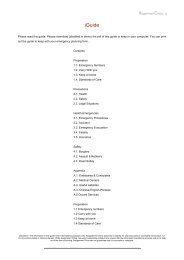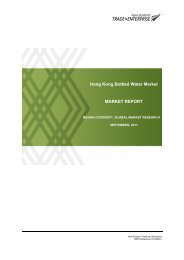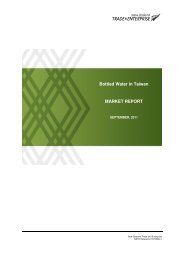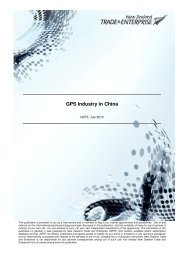China Country Brief - December 2011.pdf - PrcLive
China Country Brief - December 2011.pdf - PrcLive
China Country Brief - December 2011.pdf - PrcLive
You also want an ePaper? Increase the reach of your titles
YUMPU automatically turns print PDFs into web optimized ePapers that Google loves.
due to an expected weakening in external demandstemming from the European debt crisis, the World Bank has lowered its growth forecastsfor <strong>China</strong>, predicting growth of 9.1 and 8.4 percent respectively in 2011 and 2012.<strong>China</strong> has the fastest-growing manufacturing sector in the world and has become thepreferred destination for the relocation of global manufacturing facilities. The industrialsector accounted for 46.8 percent of GDP in 2010, with the major industries being miningand ore processing, iron, steel, aluminum, coal, machinery, textiles and apparel,chemicals, consumer electronics, automobiles and telecommunications equipment. Whileagriculture only contributes around 10 percent of GDP, it accounts for more than 40percent of the labour force and <strong>China</strong> is among the world's largest producers of rice, corn,wheat, soybeans, vegetables, tea and pork. With the expansion of the manufacturing andservice sectors, there is an increasing movement of labour away from agriculture intoannumiv. However,its reform, it has maintained an average GDP growth rate of close to 10 percent per began <strong>China</strong> Sincesectors.iiitheseSome major changes are expected to occur in <strong>China</strong> over the next decade, in particularan increasingly ageing population. By year 2017 people aged 40 years and over willconstitute approximately 52 percent of the population. There is also a new generation ofconsumers emerging from <strong>China</strong>'s years of economic hardship. They can becharacterised as young, well educated and familiar with non-Chinese cultures, with a highprobability of becoming employees of multinationals or Chinese companies that areoperating internationally. This growing middle class is typically located in the major citieson the Eastern seaboard of <strong>China</strong> and in particular in the following four cities - Beijing,Shanghai, Shenzhen and Guangzhou.Average household income is forecast to grow at an annual growth rate of 4.2 percent.Nevertheless, significant differences remain between urban and rural household incomes.On average, incomes of rural households are less than a third of those in urbanhouseholds, and this difference is forecast to remain the same over the next decade.Investment and Foreign TradeEntry into the World Trade Organization (WTO) has allowed greater volumes of importedforeign agricultural products into the main centres, predominantly around Shanghai,Beijing and Guangzhou. This continues to be an issue for the Chinese government as itgrapples with the need to revitalise its rural sectors and urbanise a large proportion of therural population. Already some 80 million people have left their place of registration to findwork in the cities and more will likely follow unless economic development of the ruralregions is achieved.Since it began its open door policy in 1978, foreign trade has become more important to<strong>China</strong>. <strong>China</strong> is now one of the world’s largest trading nations and was the seventh4/Exporter Guide | <strong>China</strong> | <strong>Country</strong> <strong>Brief</strong> | <strong>December</strong> 2011












